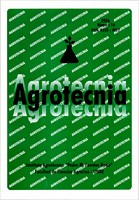Assessment of potential yield of four sweet potatoes cultivars in Corrientes
DOI:
https://doi.org/10.30972/agr.0304661Keywords:
Sweet potato, Harvest, Tuber RootsAbstract
Sweet potatoe [Ipomoea batatas (L.) Lam., Convolvulaceae family] is cultivated in the five continents, it is the seventh most cultivated food crop in the world and the third with commercial underground organs. In Argentina, the average yield is 14,9 tn ha-1 , which is considered low compared to other Latin American countries; particularly in the province of Corrientes sweet potatoe is produced with obsolete technology. The objective of this work has been to know the roots potential yield of four sweet potatoes cultivars under technical management in the agro-ecological conditions of the north of Corrientes Province. For this purpose, the experiment was carried out applying fertilization, integrated weed management and localized irrigation. The evaluated sanitized cultivares (cvs) of commercial interest had been: for short cycle Beauregarr and Arapey INIA, and for long cycle Morada INTA and Okinawa 100. For this, a randomized complete block design was used with four repetitions measuring variables such as: Number of Total (NRT), Commercial (NRC) and Non-Commercial (NRNC) Roots, Total Fresh Weight of Roots (PFT) of Commercial Roots (PFRC) and Non-Commercial Roots (PRNC) per m2 from which estimates were made per hectare. The results were submitted to the analysis of variance (ANOVA) and Tukey's test (p <0.05). The cvs Okinawa 100 and Morada INTA achieved the highest yields with 72,79 and 55,29 tn ha-1 respectively, five-fold and three-fold the average yield of the Province of Corrientes was increased. The cvs Beauregard and Arapey INIA achieved 36.42 and 33,03 tn ha-1 respectively, two-fold increased the provincial average yield. The NRC and the NRNC did not differ statistically between the cultivars evaluated.Downloads
Published
2020-12-21
How to Cite
González, C. A., Giménez, L. I., & Burgos, A. M. (2020). Assessment of potential yield of four sweet potatoes cultivars in Corrientes. Agrotecnia, (30), 89–96. https://doi.org/10.30972/agr.0304661
Issue
Section
Notas de Investigación



